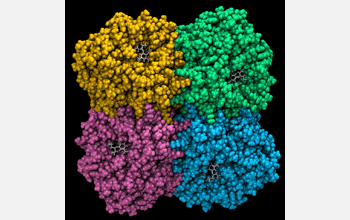Multimedia Gallery
Fighting Bird Flu
To ward off avian influenza, which some fear may one day trigger a world-wide pandemic, researchers are scurrying to develop new flu drugs to complement the current arsenal which includes Tamiflu and Relenza. In a paper published in the Journal of the American Chemical Society, a team led by University of California, San Diego (UCSD), biochemists described the nanosecond-by-nanosecond movements of a key enzyme called N1, needed to spread the infection to new cells. The simulation, performed on the San Diego Supercomputer Center's DataStar supercomputer, described the interaction of two chemical "loops" in creating a "hot pocket" region that could represent a potential target for new drugs capable of blocking N1's activity. The image here shows N1, with the anti-viral Tamiflu bound in the active sites (silver). Rommie Amaro, a postdoctoral fellow in the UCSD laboratory of J. Andrew McCammon, said her group has identified several potential inhibitors of interest. The National Science Foundation is the primary funding source for the SDSC. [Image taken from the San Diego Supercomputer Center Multimedia Gallery.] (Date of Image: 2008)
Credit: Image: R. Amaro, UCSD; Source: San Diego Supercomputer Center, UC San Diego
Special Restrictions: This image was taken from the San Diego Supercomputer Center's Multimedia Gallery and is available for use by members of the media, teachers, university staff and the general public. All media in the gallery are intended for personal, educational and nonprofit/non-commercial use only. The San Diego Supercomputer Center's Multimedia Gallery states that any media used from their gallery must be credited as stated in the caption.
Images and other media in the National Science Foundation Multimedia Gallery are available for use in print and electronic material by NSF employees, members of the media, university staff, teachers and the general public. All media in the gallery are intended for personal, educational and nonprofit/non-commercial use only.
Images credited to the National Science Foundation, a federal agency, are in the public domain. The images were created by employees of the United States Government as part of their official duties or prepared by contractors as "works for hire" for NSF. You may freely use NSF-credited images and, at your discretion, credit NSF with a "Courtesy: National Science Foundation" notation.
Additional information about general usage can be found in Conditions.
Also Available:
Download the high-resolution JPG version of the image. (310 KB)
Use your mouse to right-click (Mac users may need to Ctrl-click) the link above and choose the option that will save the file or target to your computer.



